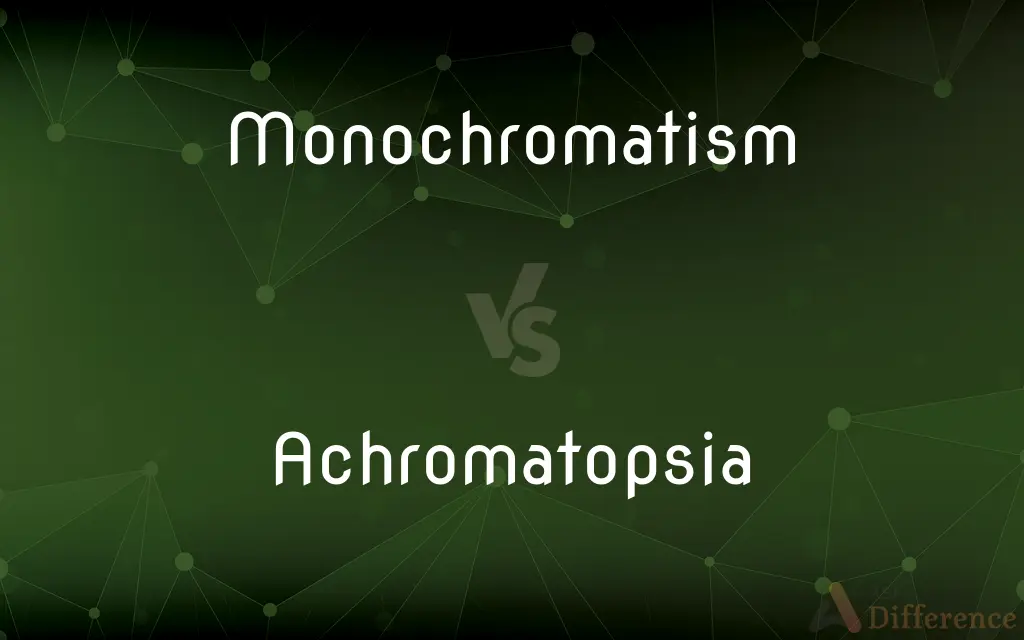Monochromatism vs. Achromatopsia — What's the Difference?
By Urooj Arif & Fiza Rafique — Updated on April 8, 2024
Monochromatism refers to seeing in one color or shades of one color, while achromatopsia is the inability to perceive color at all.

Difference Between Monochromatism and Achromatopsia
Table of Contents
ADVERTISEMENT
Key Differences
Monochromatism and achromatopsia are both related to color perception disorders, but they differ in their nature and impact on vision. Achromatopsia, on the other hand, is characterized by a complete lack of color vision, where individuals cannot perceive any color at all.
Monochromatism, often considered a form of color blindness, involves seeing in one color or shades of one color, highlighting a severe limitation in color discrimination. Unlike monochromatism, where some sense of color or its intensity may exist, achromatopsia results in seeing the world entirely in shades of grey.
Monochromatism is often the result of malfunctioning or absence of two of the three types of cone cells in the retina, which are responsible for color perception. This can be due to genetic factors or can be acquired later in life through certain types of injuries or diseases affecting the eye or brain. Achromatopsia, conversely, is usually caused by a genetic mutation affecting all three types of cone cells, leading to their complete dysfunction.
In terms of treatment, there is no cure for either monochromatism or achromatopsia. Management strategies focus on coping mechanisms, such as using tinted glasses to reduce light sensitivity and employing assistive technologies to distinguish colors. For both conditions, early diagnosis and intervention can significantly improve quality of life.
Comparison Chart
Definition
Seeing in one color or shades of one color
Complete inability to perceive color
ADVERTISEMENT
Nature
Can perceive shades of one color, severe color blindness
No color perception, sees in shades of grey
Causes
Malfunction or absence of two cone types
Genetic mutation affecting all three cone types
Associated Conditions
Can be congenital or acquired
Usually congenital, associated with other vision issues
Diagnosis
Color vision tests, ERG, possibly genetic testing
Color vision tests, ERG, genetic testing
Treatment and Management
Coping mechanisms, no cure
Coping mechanisms, assistive technologies, no cure
Compare with Definitions
Monochromatism
Involves comprehensive vision testing, including assessing color discrimination capabilities.
Specialized tests can help determine the extent of color vision deficiency in monochromatism.
Achromatopsia
A rare, inherited vision disorder characterized by a total absence of color vision, seeing the world in shades of grey.
An individual with achromatopsia cannot distinguish any colors, as their vision comprises solely of grey tones.
Monochromatism
Leads to a simplified visual experience, potentially making tasks that rely on color differentiation challenging.
Identifying ripe fruits may be difficult for someone with monochromatism.
Achromatopsia
Caused by genetic mutations affecting all three cone photoreceptor types, leading to their dysfunction.
Achromatopsia is usually an autosomal recessive trait, meaning it can be passed down from parents to children.
Monochromatism
Primarily focuses on adaptation strategies, such as using specific types of glasses to enhance visual contrast.
Tinted glasses might help a person with monochromatism navigate their environment more effectively.
Achromatopsia
Significantly affects visual tasks and quality of life, often accompanied by sensitivity to light and reduced acuity.
Someone with achromatopsia might need to wear sunglasses indoors due to extreme light sensitivity.
Monochromatism
Can be congenital, resulting from genetic factors, or acquired due to injury or disease.
Monochromatism can develop after significant damage to the eye's retina.
Achromatopsia
Requires detailed vision tests and genetic analysis to identify the specific mutations involved.
Genetic testing can confirm the diagnosis of achromatopsia, providing clarity for affected individuals.
Monochromatism
A condition where an individual perceives only one color or shades of one color, severely limiting color discrimination.
A person with monochromatism might only see the world in shades of grey, unable to distinguish between colors.
Achromatopsia
Involves managing symptoms, as there is no cure; visual aids and lifestyle adjustments are crucial.
Using devices that convert colors to different shades of grey can help someone with achromatopsia navigate their surroundings.
Monochromatism
The condition of being completely colorblind.
Achromatopsia
Achromatopsia, also known as total color blindness, is a medical syndrome that exhibits symptoms relating to at least five conditions. The term may refer to acquired conditions such as cerebral achromatopsia, but it typically refers to an autosomal recessive congenital color vision condition, the inability to perceive color and to obtain satisfactory visual acuity at high light levels, typically exterior daylight.
Monochromatism
The condition of being monochromatic
Achromatopsia
Achromatopia
Monochromatism
(pathology) The condition of being totally colour blind; achromatopsia
Monochromatism
Complete color blindness; colors can be differentiated only on the basis of brightness
Common Curiosities
How does achromatopsia differ from monochromatism?
Achromatopsia is a condition characterized by a total lack of color perception, where individuals see the world entirely in shades of grey, unlike monochromatism, which allows for some color perception.
How are these conditions diagnosed?
Diagnosis involves a series of vision tests, including color vision tests and electroretinography, to assess cone cell functionality and identify genetic mutations.
Can achromatopsia be cured?
There is currently no cure for achromatopsia, but symptoms can be managed with visual aids and lifestyle adjustments.
What is monochromatism?
Monochromatism is a vision condition where an individual can only perceive one color or shades of that color, leading to a limited ability to differentiate colors.
What are the symptoms of achromatopsia?
Symptoms include a total absence of color vision, light sensitivity, poor visual acuity, and sometimes involuntary eye movements.
Do people with monochromatism see in black and white?
Yes, people with complete monochromatism see the world in black, white, and various shades of grey.
What causes monochromatism?
It can be caused by genetic factors leading to the malfunctioning or absence of two cone types in the retina, or by acquired factors such as injury or disease.
Are there any treatments for monochromatism?
There is no cure, but coping strategies and assistive technologies can help improve quality of life.
Can achromatopsia develop later in life?
Achromatopsia is primarily congenital, meaning it is present at birth, and does not typically develop later in life.
How does monochromatism affect daily life?
It can make tasks that rely on color differentiation, such as driving or choosing ripe fruits, challenging and require adaptation strategies.
Is monochromatism common?
Monochromatism is rare, with a very low prevalence in the general population.
Can achromatopsia be inherited?
Yes, achromatopsia is usually inherited in an autosomal recessive pattern, meaning it can be passed from parents to their children.
How does light sensitivity affect individuals with achromatopsia?
Light sensitivity can be severe, making bright environments uncomfortable and necessitating the use of sunglasses or tinted lenses indoors.
What adaptive technologies assist individuals with these conditions?
Technologies include color identification apps, specialized glasses to enhance contrast, and devices that convert colors into distinguishable patterns or shades.
Is genetic testing available for achromatopsia?
Yes, genetic testing can identify mutations associated with achromatopsia, aiding in diagnosis and understanding of the condition.
Share Your Discovery

Previous Comparison
Rainy vs. Sunny
Next Comparison
Leftovers vs. DebrisAuthor Spotlight
Written by
Urooj ArifUrooj is a skilled content writer at Ask Difference, known for her exceptional ability to simplify complex topics into engaging and informative content. With a passion for research and a flair for clear, concise writing, she consistently delivers articles that resonate with our diverse audience.
Co-written by
Fiza RafiqueFiza Rafique is a skilled content writer at AskDifference.com, where she meticulously refines and enhances written pieces. Drawing from her vast editorial expertise, Fiza ensures clarity, accuracy, and precision in every article. Passionate about language, she continually seeks to elevate the quality of content for readers worldwide.
















































